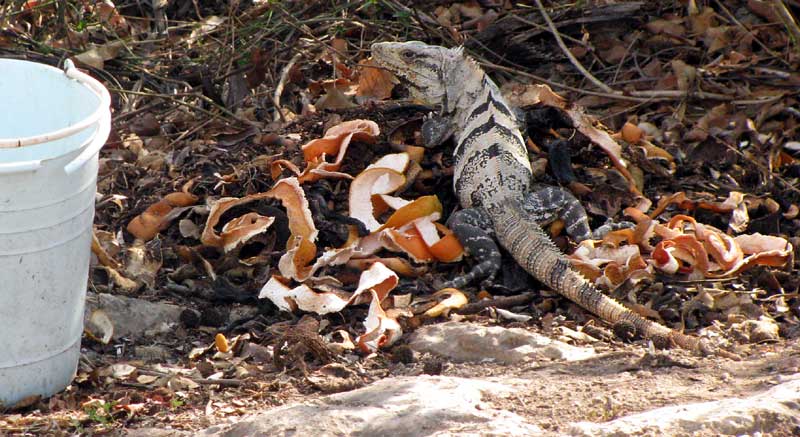Excerpts from Jim Conrad's
Naturalist Newsletter
from the April 4, 2010 Newsletter issued from Hacienda Chichen Resort beside Chichén Itzá Ruins, central Yucatán, MÉXICO
COMPOSTING & PEEING IN THE TROPICS
In my life with no plumbing atop a limestone hill next to a 16th century church often visited by tourists, what do I do with all the orange and banana peelings I generate, and with my own excreta? There's a bathroom three or four minutes away, so that takes care of part of the problem. However, I drink a lot and can't run down the hill every time I want to pee, plus there are the fruit peelings.
I compost all that.
There's not much written about small-scale composting in tropical lowlands, so here's my contribution.
One reason there's little written about the topic is that in most tropical villages kitchen remains are not regarded as a problem. If you peel a banana or crack an egg, you throw the peeling or shell out the door and the chickens and pigs fight over it, eventually converting it to manure spread randomly in the neighborhood. If it's a bone, the dog gets it.
That doesn't mean that compositing isn't needed. The way most tropical village folks I've seen handle their own excreta is unsanitary, usually consisting of depositing it into a shallow pit that gradually leaks out the liquid, or overflows during rains, spreading it about. What's left either eventually is abandoned and a new pit is dug, or else it gets cleaned out by floods, pigs, chickens or whatever. Especially in the Yucatán where waterflow is subterranean and the limestone bedrock is fractured and leaky, such pits contaminate the groundwater nearby and maybe far away.
Back in 2003 when I was hermiting in Mississippi I composted my own excreta. I wrote all about it at www.backyardnature.net/n/x/mymanure.htm.
On my hill here I needed a way not only to get rid of my abundant fruit peelings but also someplace to pee that wouldn't stink up the neighborhood. My solution has been to adapt my old hermiting technique.
First I heaped up a bushel of dry leaves, then I started dumping my peelings there. And peeing on it, and regularly stirring it all, aerating it. I find that most compost heaps fail because it's not understood that air, water, carbohydrate and nitrogen all need to be kept at a certain balance. In my heap the leaves and peelings provide carbohydrate, my pee provides the water and nitrogen, and stirring the heap lets air in.
The astonishing thing is that each week I dump about half a full backpack of fruit peelings on the heap, frequently add fallen leaves from the lawn, and pee on it several times each day, yet after five months the heap is actually smaller then when I began, and it doesn't stink. If you put your nose right up to it on a hot day, maybe, but it doesn't create an unpleasantness the way most peeing spots do.
My hermiting technique described at the above link should be tried by more people in the tropics who need to get rid of their own excreta. If attention is paid to heap temperature during the composting period, assuring that even intestinal parasites are killed by heat, fertilizer can be produced in a land where fertilizer is sorely needed. What I don't know is whether excreta from people who eat flesh will compost as easily as my own vegetarian output.
I do know, however, that if all you want is to get rid of your peelings, and your pee, my bushel-basket-size compost heap does the job admirably. My heap is shown at the bottm of this page.
The iguana atop the might provide one reason why the heap doesn't grow. Iguanas eat most of my banana peelings (though none of my orange peelings). The bucket at the side holds leaves raked from the lawn, which I cover the heap with from time to time. When so many orange peelings accumulate as in the picture, it's time to flip the heap so that fresh peelings are inside the heap or on the bottom.
